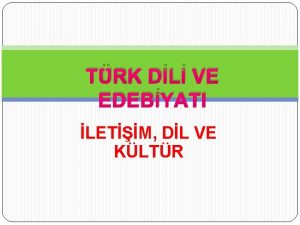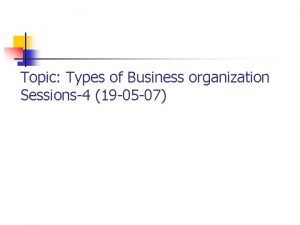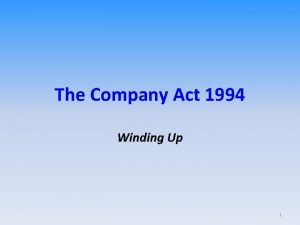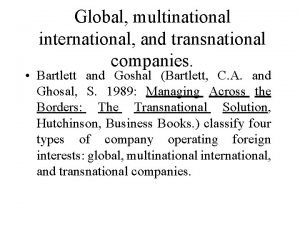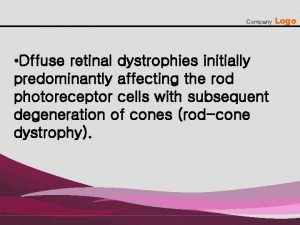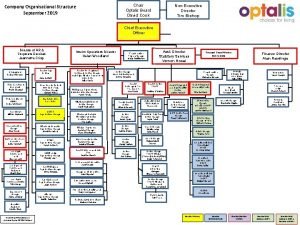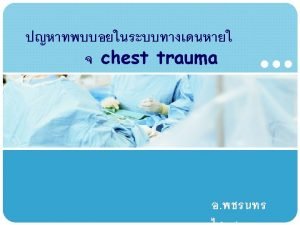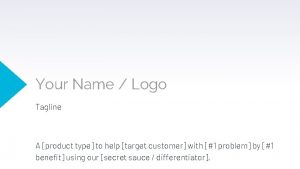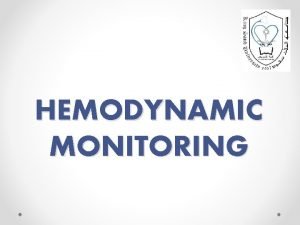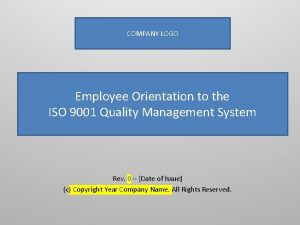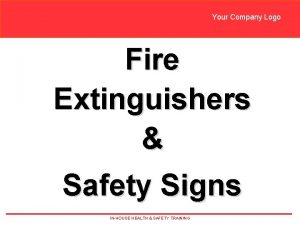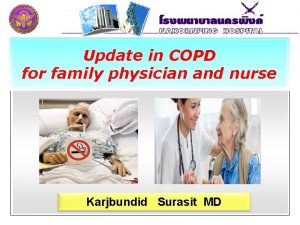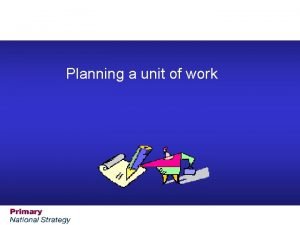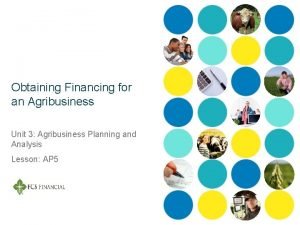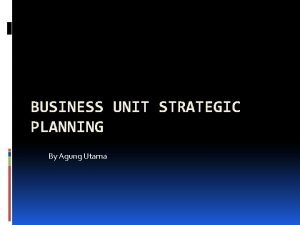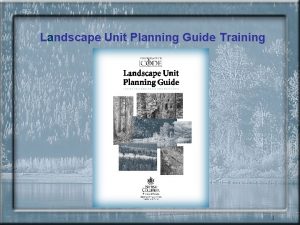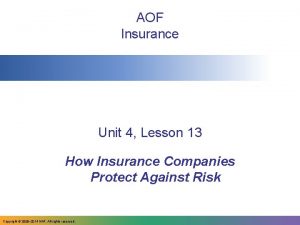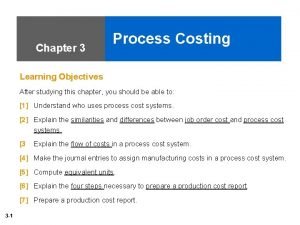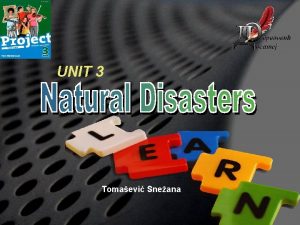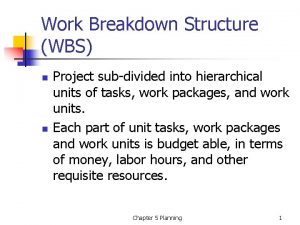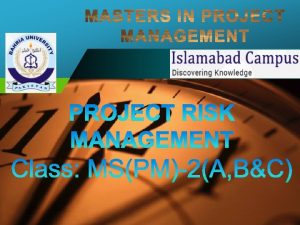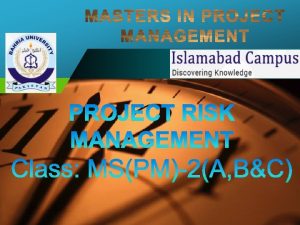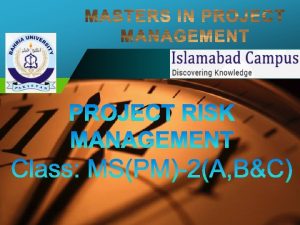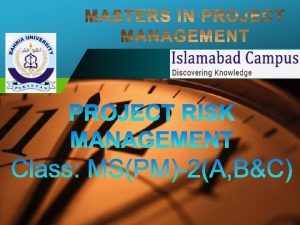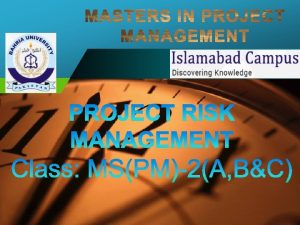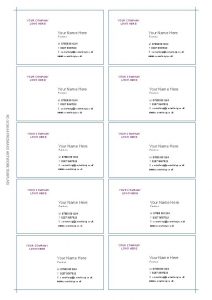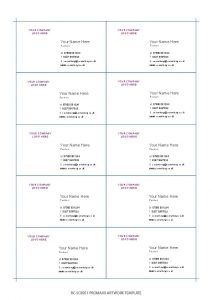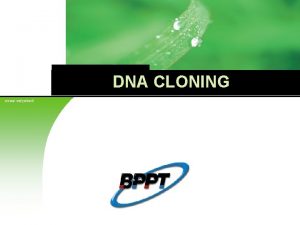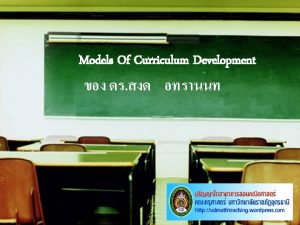Company LOGO Company LOGO oner Unit 10 Planning



























































- Slides: 59

Company LOGO

Company LOGO oner.

Unit 10. Planning Risk Responses Content Purpose and Objective of the Plan Risk Responses Process Critical Success Factors for the Plan Risk Responses Process Risk Response Strategies Tools and Techniques Documenting the Results Learning Objectives Understanding the Project Environment and various types of Risk Responses which can be planned for positive as well as negative risks (threats and opportunities)

UNIT 10 PLAN RISK RESPONSES

UNIT 10 Understanding the Project Environment and various types of Risk Responses which can be planned for positive as well as negative risks (threats and opportunities).

UNIT 10 What is the Project Environment? Response Options System Standards Insurance Response Planning Purpose and Objective of the Plan Risk Responses Process Critical Success Factors for the Plan Risk Responses Process Contingency Reserves Risk and Safety Principal Determinants Managing by Stakeholder Groupings and categories The Means and Value of Exercising Positive Influence Risks in Contracts Tools & Techniques for the Plan Risk Responses Process Documenting the Results of the Plan Risk Responses Process

UNIT 8

UNIT 10 • The Plan Risk Responses process determines effective response actions that are appropriate to the priority of the individual risks and to the overall project risk. • It takes into account the stakeholders’ risk attitudes and the conventions specified in the Risk Management Plan, in addition to any constraints and assumptions that were determined when the risks were identified analyzed. From Practice Standard for Project Risk Management, 1 st Ed, PMI

UNIT 10 • The objective of the Plan Risk Responses process is to determine the set of actions which most enhance the chances of project success while complying with applicable organizational and project constraints. • Once risks have been identified, analyzed and prioritized, plans should be developed for addressing every risk the project team considers to be sufficiently important, either because of the threat it poses to the project objectives or the opportunity it offers. From Practice Standard for Project Risk Management, 1 st Ed, PMI

UNIT 10 • The planning entails agreeing upon the actions to be taken and the potential changes to budget, schedule, resources, and scope which these actions might cause. • Contingent risk response actions need to be executed at the optimum time. For this reason, the response specification for each such risk should include a description of any corresponding trigger conditions. From Practice Standard for Project Risk Management, 1 st Ed, PMI

UNIT 10 • The responsibility for monitoring the project conditions and implementing the corresponding actions should be clearly assigned. • Every risk should have been allocated to a risk owner as part of the Identify Risks process, and each of the corresponding risk responses should now be assigned to a specific risk action owner. • The risk owner is responsible for ensuring that the risk response is effective and for planning additional risk responses if required, whereas the risk action owner is responsible for ensuring that the agreed-upon risk responses are carried out as planned, in a timely manner. • The role of the risk owner and that of the risk action owner may be assigned to a single person. From Practice Standard for Project Risk Management, 1 st Ed, PMI

UNIT 10 • Responses, when implemented, can have potential effects on/the project objectives and, as such, can generate additional risks. • These are known as secondary risks and have to be analyzed and planned for in the same way as those risks which were initially identified. From Practice Standard for Project Risk Management, 1 st Ed, PMI

UNIT 10 • It is never feasible or even desirable to eliminate all threats from a project. • Similarly, there is also a limit to the extent to which opportunities can be proactively managed. • There may be residual risks that will remain after the responses have been implemented. • These residual risks should be clearly identified, analyzed, documented, and communicated to all relevant stakeholders. From Practice Standard for Project Risk Management, 1 st Ed, PMI

UNIT 10 • All the approved, unconditional actions arising from risk response planning should be integrated into the project management plan in order to ensure that they are carried out as part of normal project implementation. • The corresponding organizational and project management rules should also be invoked, including the following: • Project change management and configuration control • Project planning, budgeting, and scheduling • Resource management, and • Project communication planning From Practice Standard for Project Risk Management, 1 st Ed, PMI

PLAN RISK RESPONSES

8 2 Risk Planning Process 11. 5 1 PROCESS OF DEVELOPING OPTIONS AND ACTIONS TO ENHANCE OPPORTUNITIES AND TO REDUCE THREATS TO PROJECT OBJECTIVES. 2 Tools and Techniques 3 11. 5 Inputs • Risk Register • Risk Management Plan ______ _ Outputs • Strategies for • Risk Register Negative Updates Risks or • Risk Related Threats Contract • Strategies for Decisions Positive Risks • Project or Management Opportunities Plan Updates • Contingent Response • Project Strategies Document Updates • Expert Reference: Figure 11. 17. Judgment ______ PMBOK® Guide, 4 th Ed

Reference: Figure 11. 19. PMBOK® Guide, 5 th Ed

Reference: Figure 11. 18. PMBOK® Guide, 4 th Ed

• • • Hazard Prevention Risk Avoidance Risk Transfer Likelihood Reduction Contingency Planning

• • • Risk Exposure Confidence of the risk assessment Compound Risks The number of Risks Cost of Action – Risk Reduction Leverage – Cost Benefit

Mitigation (Corrective action) Acceptance (Accept consequences) Avoidance (Prevention) Transference (Shift Responsibility)

RISK RESPONSE STRATEGIES NEGATIVE STRATEGIES AVOID TRANSFER MITIGATE ACCEPT POSITIVE STRATEGIES ENHANCE SHARE EXPLOIT ACCEPT

Results from a Monte Carlo Simulation of a Project Schedule 100 Cumulative Probability 90 80 70 60 50 40 30 20 10 0 110 120 130 140 150 160 170 180 190 200 Days After Project Start This S-curve shows the cumulative probability of project completion by a particular date. For example, the intersection of the dashed ones shows that there is a 50 percent probability that the project will be finished within 145 days of its start. Project completion dates toward the left have higher risk while those toward the right have lower risk.

Seller Risk LOW HIGH LOW CPPC CPFF 100 0 Cost Plus Percentage of Costs (CPPC) CPIF FPI Variable Sharing Ratio Cost Plus Fixed Fee (CPFF) Cost Plus Incentive Fee (CPIF) Spectrum of risk Buyer Risk FFP 0 100 Fixed Price Incentive (FPI) Firm Fixed Price

• Direct property damage – Insurance of principal assets, e. g. , equipment, materials, property, auto • Indirect consequential loss – Indirect loss suffered by third party, resulting from actions by the contractor • Legal liability – Design errors, public bodily injury, project-performance failure • Personnel – Bodily injury • Wrap-up insurance – All the above integrated into one agreement – usually provided by the owner

UNIT 10

UNIT 10 8. 2. 1 8. 2. 2 8. 2. 3 8. 2. 4 8. 2. 5 8. 2. 6 Communicate Define Roles and Responsibilities Specify Timing of Responses Provide resources, budget and schedule Address interactions of risks and responses Ensure appropriate, timely, effective, and agreed-upon responses 8. 2. 7 Address threats and opportunities 8. 2. 8 Develop strategies From Practice Standard for Project Risk Management, 1 st Ed, PMI

UNIT 10 From Practice Standard for Project Risk Management, 1 st Ed, PMI

UNIT 10 • Communication with the various stakeholders should be maintained in an open and appropriate manner. • The resulting plans are disseminated and approval obtained in order to ensure full acceptance by all stakeholders. • Organizational causes of risk should be addressed openly • Culture • Attitudes • Disagreements concerning objectives • This may require involving high levels of the organization’s management and other stakeholders. From Practice Standard for Project Risk Management, 1 st Ed, PMI

UNIT 10 • The risk response success will be dependent upon the full support and involvement of the project team and other stakeholders. • The key roles for Project Risk Management are those of risk owner and risk action owner. • A single risk owner should be assigned to every identified risk, and each agreed-upon risk response should have a single risk action owner. • The people with the corresponding responsibilities should be aware of what is expected of them, and the other project stakeholders should understand accept the needs and authority of these roles. • Management may take ownership of risks with political, organizational causes. • In addition, senior management should approve and track associated risk-related contingency reserves. From Practice Standard for Project Risk Management, 1 st Ed, PMI

UNIT 10 • Agreed-upon responses should be integrated into the project management plan and will therefore be scheduled and assigned for execution. • The responses that depend on uncertain conditions should be monitored so as to be performed if the conditions warrant them. From Practice Standard for Project Risk Management, 1 st Ed, PMI

UNIT 10 • Each response should be planned in detail in accordance with the methodology of the project and integrated into the project management plan. It entails, • Estimating the resources, costs, and duration • Updating the budget and schedule • Obtaining approval from management • Obtaining commitment from the risk owners and risk action owners. • Management’s role at this stage is vital for • Supporting the project manager in developing risk responses and • Authorizing the corresponding resources. From Practice Standard for Project Risk Management, 1 st Ed, PMI

UNIT 10 • Responses may be developed to address risks related by: • Cause and effect, or • Common root cause • Categorization of risks may help identify and address responses, by using tools such as • Risk Breakdown structure • Affinity Diagram • Other categorization tools From Practice Standard for Project Risk Management, 1 st Ed, PMI

UNIT 10 • There is also a need during the Plan Risk Responses process to consider the risks aggregated during the Perform Quantitative Risk Analysis process and then develop generic responses where possible. • Another interaction effect that may occur is when one risk, if it occurs, may affect the probability or impact of other risks. • Deciding on the response strategy may require a compromise, since some proposed responses may be mutually exclusive or counterproductive. • Mitigating a threat to time could cost money, thereby increasing pressure on the budget. • Risk response planning also needs to take a holistic view of all proposed responses and make sure they are coherent. From Practice Standard for Project Risk Management, 1 st Ed, PMI

UNIT 10 • The challenge therefore in planning responses to risks is the need to control the potential effects of the strategy developed for treating the original risk. • If this is overlooked, the total level of threat in a project can actually increase, or the potential for opportunities can be compromised. From Practice Standard for Project Risk Management, 1 st Ed, PMI

UNIT 10 • In general, responses should be appropriate, timely, costeffective, feasible, achievable, agreed-upon, assigned and accepted. • Any proposed risk response plan needs to be assessed against the following criteria: • Consistency with organizational values, project objectives, and stakeholder expectations. • Technical feasibility • Ability of the project team or risk action owners outside the project to carry out the corresponding actions • Balance between overall impact of the response on the project objectives and the improvement in the risk profile of the project. From Practice Standard for Project Risk Management, 1 st Ed, PMI

UNIT 10 • Risk response planning should combine responses that address the threats as well as those that provide for opportunities into a single, integrated plan. • If either threats or opportunities are not fully addressed, the combined set of response strategies will be incomplete and may even be invalid. From Practice Standard for Project Risk Management, 1 st Ed, PMI

UNIT 10 • Risk response planning should be carried out in an open -minded manner rather than adopting the first response that seems to be feasible. • The responses should be planned at a general, strategic level and the strategy validated and agreed upon, prior to detailed tactical approach. • Once the responses have been planned at a strategic level, they should be expanded into actions at the tactical level and integrated into the project management plan. • This activity may generate additional secondary risks, which will need to be addressed at this time. From Practice Standard for Project Risk Management, 1 st Ed, PMI

UNIT 10

UNIT 10 Threats / Negative Risks 8. 3. 1 Avoid a Threat Transfer 8. 3. 2 Mitigate Accept 8. 3. 3 Opportunities / Positive Risks Exploit an Opportunity Share Enhance Accept 8. 3. 4 From Practice Standard for Project Risk Management, 1 st Ed, PMI

UNIT 10 • This strategy involves taking the actions required to address a threat or an opportunity in order to ensure either that the threat cannot occur or can have no effect on the project, or that the opportunity will occur and the project will be able to take advantage of it. • This strategy entails transference to a third party that is better positioned to address a particular threat or opportunity. From Practice Standard for Project Risk Management, 1 st Ed, PMI

UNIT 10 • Mitigation and enhancement are the most widely applicable response strategies. • Here, the approach is to identify actions that will decrease the probability and/or the impact of a threat, and increase the probability and/or impact of an opportunity. • This strategy applies when the other strategies are not considered applicable or feasible. • Acceptance entails taking no action unless the risk actually occurs, in which case contingency or fallback plans may be developed ahead of time, to be implemented if the risk presents itself. From Practice Standard for Project Risk Management, 1 st Ed, PMI

UNIT 10 • In addition to responding to individual risks, the four risk response strategies can be applied to address overall project risk as follows: • Cancel the project, as a last resort, if the overall level of risk remains unacceptable. • Set up a business structure in which the customer and the supplier share the risk. • Re-plan the project or change the scope and boundaries of the project, e. g. , by modifying the project priority, resource allocations, delivery calendar, etc. • Pursue the project despite a risk exposure that exceeds the desired level. From Practice Standard for Project Risk Management, 1 st Ed, PMI

UNIT 10

UNIT 10 There are four categories of tools and techniques, as follows: 8. 4. 1 Creativity tools to identify potential responses 8. 4. 2 Decision-support tools for determining the optimal potential response. 8. 4. 3 Strategy implementation techniques designed to turn a strategy into action 8. 4. 4 Tools to transfer control to the Monitor and Control Risks process From Practice Standard for Project Risk Management, 1 st Ed, PMI

UNIT 10 From Practice Standard for Project Risk Management, 1 st Ed, PMI

UNIT 10 • Risk Response Planning builds on the available information about the potential risks and aims to determine the optimal set of responses. • For this reason, it should involve subject matter experts and employ creativity techniques in order to explore all of the options. • Project planning and execution techniques are then required to evaluate the potential effects of the various options on the project’s objectives. From Practice Standard for Project Risk Management, 1 st Ed, PMI

UNIT 10 • Once the set of potential responses for the risks being addressed is established, decision-support techniques may need to be applied to select the best possible subset from these responses. • The selection process should take into account the cost of the responses, the impact on the project objectives, uncertainty of outcomes and the possible secondary and residual risks. • The Identify Risks, Perform Quantitative Risk Analysis, and Plan Risk Responses processes may then need to be applied to the resultant project management plan and the residual and secondary risks that it would entail. • This iterative approach continues until all of the individual risks are deemed acceptable and the overall risk is within a predefined threshold. From Practice Standard for Project Risk Management, 1 st Ed, PMI

UNIT 10 • Project planning tools are used to turn the chosen strategies into concrete actions and to integrate these into existing plans. • The corresponding actions may be unconditional (i. e. , integrated into the project management plan) or contingent on a trigger condition and predefined as a contingency response strategy. From Practice Standard for Project Risk Management, 1 st Ed, PMI

UNIT 10 • The project manager needs to use resource assignment processes to ensure the availability of an owner for each risk and for each response action, so that each associated risk is managed and each corresponding risk response is carried out in a timely and effective manner. • To enable risk monitoring to identify the imminence or actual occurrence of the corresponding event, every contingency response strategy should include a set of trigger conditions. • The responsibility for monitoring these conditions should be clearly assigned in the Plan Risk Responses process and managed in the Monitor and Control Risks process. From Practice Standard for Project Risk Management, 1 st Ed, PMI

UNIT 10 • The strategic definition of risk responses should include measurable criteria for success of the response. • Risk action owners should monitor their assigned risks, take agreed-upon actions as required, and provide the risk owners with relevant information on status or changes to the risk characteristics. • Risk owners should assess the effectiveness of any actions, decide whether additional actions are required, and keep the project manager informed of the situation. From Practice Standard for Project Risk Management, 1 st Ed, PMI

UNIT 10

UNIT 10 • Risk response planning is based on the information placed in the risk register during execution of the Identify Risks and Perform Analysis processes. • The corresponding risk response information is often referred to as the risk response plan, although it may in fact be integral part of the risk register. From Practice Standard for Project Risk Management, 1 st Ed, PMI

UNIT 10 • The response-related information for each risk is recorded in the risk register and updated regularly. • Any interested stakeholder should be able to rapidly access all the information required to verify their responsibilities and manage the risks in accordance with the risk response plan. • The set of residual risks and their priorities are clearly identified and recorded. From Practice Standard for Project Risk Management, 1 st Ed, PMI

UNIT 10 • While developing the detailed set of risk responses, the project-related implications are evaluated for inclusion in a modified project management plan. • These include costs, resource assignments, scheduling details. And changes to project documentation. • Until these changes are formally approved along with the additional risks that they may carry, risk response planning cannot be considered complete. From Practice Standard for Project Risk Management, 1 st Ed, PMI

UNIT 10 • Once the risk responses have been defined and integrated into the project management plan, the individual and overall residual risks related to this plan are evaluated in order to determine whether additional response planning is required. • This evaluation should provide an estimate of both the expected post-response situation and the potential improvement of the risk exposure assuming that the proposed responses are effective. • The evaluation should be documented. From Practice Standard for Project Risk Management, 1 st Ed, PMI

UNIT 9

The End THE END THANK YOU

 Dil dışı göstergeler nelerdir
Dil dışı göstergeler nelerdir Unit 6 review questions
Unit 6 review questions Strategic planning vs tactical planning
Strategic planning vs tactical planning Goal achievement matrix
Goal achievement matrix Scenario planning workforce planning
Scenario planning workforce planning Proactive planning and reactive planning
Proactive planning and reactive planning Aggregate planning is capacity planning for:
Aggregate planning is capacity planning for: Short, medium and long term planning in education
Short, medium and long term planning in education Figurative language slideshare
Figurative language slideshare Aggregate planning is capacity planning for
Aggregate planning is capacity planning for Capacity aggregation example
Capacity aggregation example Company-wide planning
Company-wide planning Company wide strategic planning
Company wide strategic planning Private company vs public company
Private company vs public company Members voluntary winding up
Members voluntary winding up Consolidated balance sheet meaning
Consolidated balance sheet meaning Multinational vs international company
Multinational vs international company What type of company was the virginia company
What type of company was the virginia company Company logo
Company logo Company logo
Company logo Lurvin munisami
Lurvin munisami Logo
Logo Company name logo tagline
Company name logo tagline Compagnie des indes orientales pronunciation
Compagnie des indes orientales pronunciation Swan catheter
Swan catheter Iso company logo
Iso company logo Company logo transfers
Company logo transfers Virtual reality company in oman
Virtual reality company in oman Company logo
Company logo Lost and found notice
Lost and found notice Lama laba sama saba
Lama laba sama saba Company logo
Company logo Company logo
Company logo Insert company logo here
Insert company logo here Abc company logo
Abc company logo Work unit planning
Work unit planning Unit 35 agribusiness planning
Unit 35 agribusiness planning Business unit strategic planning
Business unit strategic planning Unit 009 comic
Unit 009 comic Landscape unit planning guide
Landscape unit planning guide Unit 2 lesson 3 health insurance and financial planning
Unit 2 lesson 3 health insurance and financial planning Economics unit 2 lesson 7
Economics unit 2 lesson 7 Company structure unit 3
Company structure unit 3 Company structure unit 3
Company structure unit 3 Cost of production report
Cost of production report Unit 3 logo
Unit 3 logo Surplus keuangan adalah
Surplus keuangan adalah Right triangle trigonometry
Right triangle trigonometry Si vs english units
Si vs english units Unit test algebra 2
Unit test algebra 2 Perhitungan unit cost rekam medis
Perhitungan unit cost rekam medis Unit process and unit operation
Unit process and unit operation Unit operation and unit process
Unit operation and unit process Kerangka konseptual standar akuntansi pemerintahan
Kerangka konseptual standar akuntansi pemerintahan The night pirates activities
The night pirates activities Informal letter plan
Informal letter plan Formal letter format class 10
Formal letter format class 10 Wbs travel plan
Wbs travel plan Bad planning gif
Bad planning gif What is a strategic plan
What is a strategic plan
